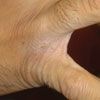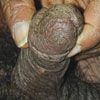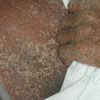- Clinical Technology
- Adult Immunization
- Hepatology
- Pediatric Immunization
- Screening
- Psychiatry
- Allergy
- Women's Health
- Cardiology
- Pediatrics
- Dermatology
- Endocrinology
- Pain Management
- Gastroenterology
- Infectious Disease
- Obesity Medicine
- Rheumatology
- Nephrology
- Neurology
- Pulmonology
Skin Disorders in Elderly Persons: Part 6, Scabies
A number of factors heighten the risk of parasitic infections in elderly persons, who often live in communal settings (eg, nursing homes), where they are more likely to encounter parasites, such as the scabies mite.
A number of factors heighten the risk of parasitic infections in elderly persons, who often live in communal settings (eg, nursing homes), where they are more likely to encounter parasites, such as the scabies mite. Debilitated patients are particularly susceptible to infestation and are thus at increased risk for the development of crusted, or Norwegian, scabies.
Here I describe and illustrate the manifestations of scabies in older adults.
DIAGNOSIS
Scabies is caused by infestation with Sarcoptes scabiei var hominis. It occurs worldwide and is highly contagious.

Figure 1

Figure 2

Figure 3
Scabies manifests as papules, pustules, burrows, nodules and, occasionally, urticarial papules and plaques. It can resemble eczema and psoriasis. Lesions are commonly found on the wrists, finger webs (
Figure 1
), antecubital fossae, axillae, areolae, periumbilical region, and genitals, including the penis (
Figure 2
). Mostpatients with scabies experience severe pruritus.
A subset of patients have Norwegian scabies (
Figure 3
).These patients, who are usually debilitated or immunocompromised, experience little or no pruritus and therefore do not scratch. As a result, hundreds to millions of mites are free to multiply and to infest the skin; the infestation manifests as confluent crusted plaques topped by thick hyperkeratotic scales.
Diagnosis of scabies is based on the patient history, physical examination results, and demonstration of mites, eggs, or scybala (black or brown football-shaped masses of feces of scabies mites) on microscopic examination.
TREATMENT
Treatment options.
A variety of topical and oral therapies can eradicate scabies. Topical treatments include:
• permethrin cream.
• lindane (gamma benzene hexachloride) lotion. (This product is banned in California.)
• precipitated sulfur in petrolatum.
• Crotamiton.
• Malathion.
• Allethrin spray.
• Benzyl benzoate.
The only oral treatment is ivermectin, which is approved by the FDA for the treatment of strongyloidiasis but is not indicated for scabies in the United States. However, ivermectin is highly effective and safe. It is an excellent treatment for patients with Norwegian scabies. For each administration, the dose is 250 µg/kg (typically 12 mg); 2 doses are given, 1 week apart.
I recommend using a scabicide-either oral or topical-once a week over a period of 2 to 3 weeks.
Whom to treat.
Any elderly patient who complains of pruritus should be assessed for scabies. Because treatment has few side effects (with the possible exception of lindane), it can be prescribed with a low index of clinical suspicion.
During an outbreak of scabies in a nursing home, it can be useful to treat all residents, staff, and frequent visitors even if they have no symptoms. However, such treatment of wide-scale outbreaks can be logistically and politically complicated from the vantage points of union relations and human resource management and must be undertaken with care and planning.
References:
REFERENCES:
1.
Scheinfeld N. Controlling scabies in institutional settings: a review of medications, treatment models, and implementation.
Am J Clin Dermatol
. 2004;5:31-37.
2.
Weinberg JM, Scheinfeld NS. Cutaneous infections in the elderly: diagnosis and management.
Dermatol Ther
. 2003;16:195-205.
3.
Weinberg JM, Vafaie J, Scheinfeld NS. Skin infections in the elderly. Dermatol Clin. 2004;22:51-61.
